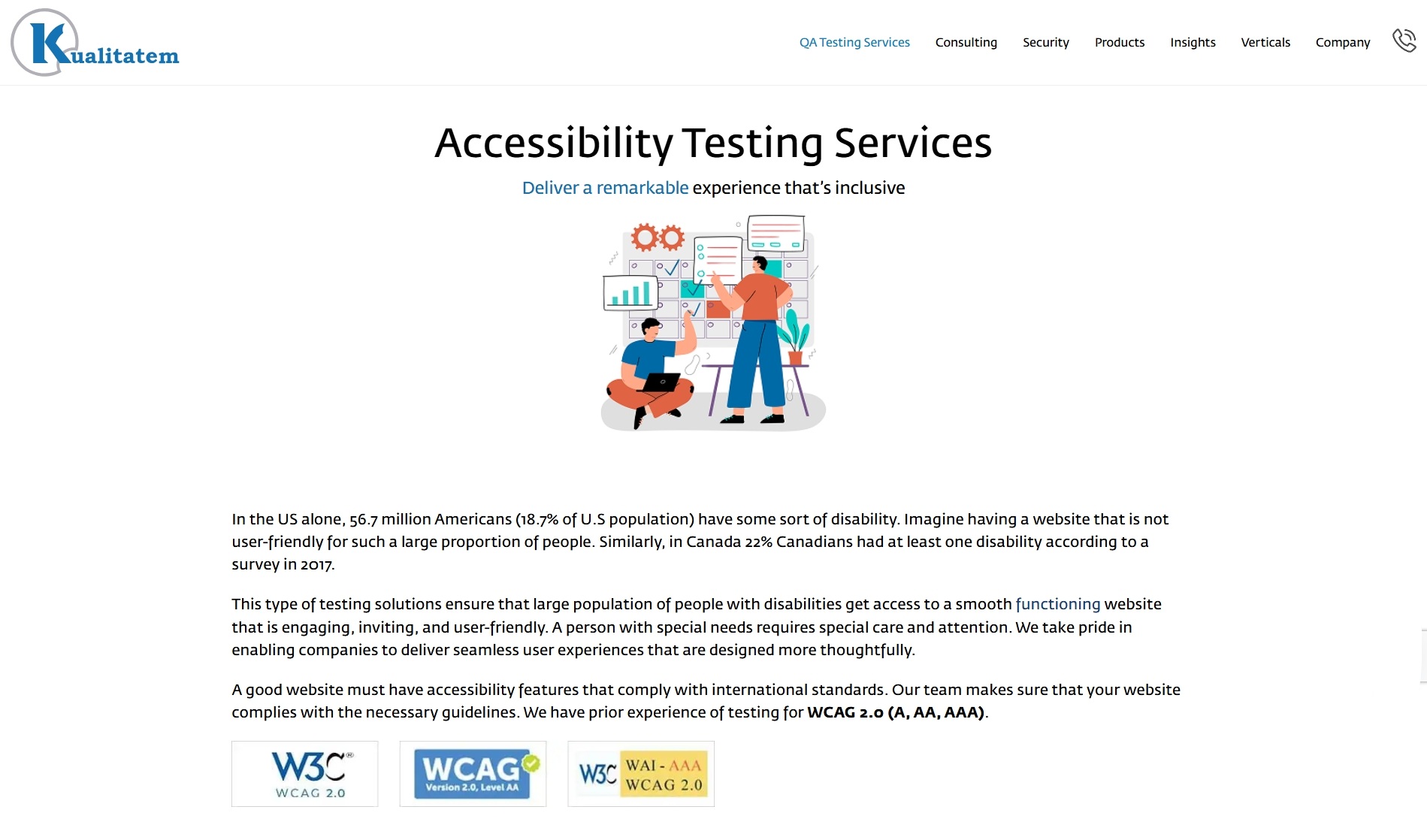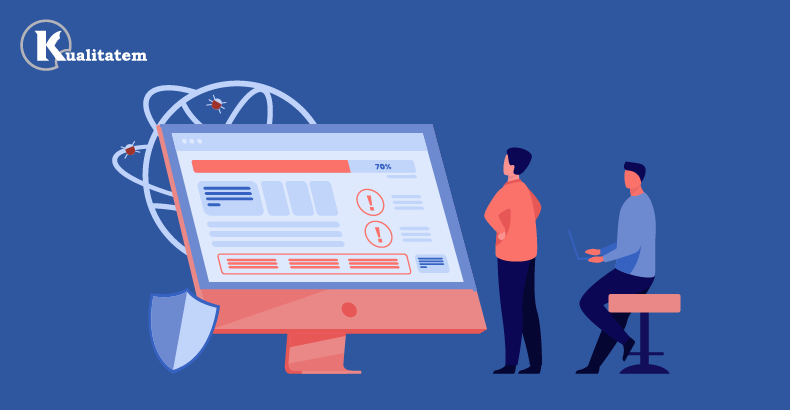Accessibility Testing for Complex Web Applications: Challenges, Tools, and Solutions

- August 29, 2025
- Zunnoor Zafar
Web applications aren’t like they used to be. They’re not that simple. The features are complex, and the needs of users are growing. Yeah, these complex features improve the functionality and user engagement. But they also introduce new challenges.
One main challenge that comes up is regarding accessibility for users with disabilities. It has to be ensured that everyone can interact with the application. No one should feel left out, including people with disabilities. This is not just a legal obligation but an important aspect of delivering a good user experience.
And besides just people’s disabilities, accessibility considerations also include the fact that the application should work correctly on different screen sizes.
This is where accessibility testing, which falls within the broader umbrella of QA testing, shines. Let’s talk about it in detail.
Why Does Accessibility Testing Matter for Complex Web Applications?
So basically, accessibility testing verifies that software applications are usable by everyone. Even by people with various disabilities. Including visual, auditory, cognitive, and other impairments.
Other things are also included in this testing. For example, making sure the applications work on all devices and screen sizes.
When it comes to complex web applications, especially ones that feature rich interactive elements. Along with dynamic content updates and multimedia, accessibility is often overlooked. It isn’t considered an important element. But it is.
And why is that? Well, for the following reasons.
- Legal Compliance: Governments across the world enforce web accessibility standards. These standards include ADA and WCAG. There’s also EN 301 549 in Europe. This means that accessibility testing is a compliance requirement.
- Inclusive User Experience: A complex user interface must always be inclusive. For users relying on screen readers, keyboard navigation or alternative input devices, accessible design means equal usability.
- Market Reach and Brand Loyalty: Over a billion people worldwide have some form of disability. And the number of devices that people use is even bigger. Accessibility caters to these numbers and improves your customer base, and strengthens brand reputation.
- SEO and Performance Benefits: Many accessibility practices overlap with SEO best practices. They improve site rankings and overall performance.
Considering these reasons, businesses should do proper accessibility testing on their software applications. They can either hire an in-house team to do it or partner with a QA service provider.
Challenges in Accessibility Testing for Complex Web Applications
With great value comes great challenges (we made this up). This is the thing with accessibility testing. Especially for complex web applications with multiple layers of interactivity and advanced UI components. That said, some of the primary challenges are as follows.
1. Dynamic and Rich User Interfaces
Applications often use JavaScript frameworks (like React, Angular or Vue). They do it to dynamically render content and UI elements. This creates difficulties in ensuring ARIA (accessible rich internet applications) roles and properties dynamically update correctly.
And the misery doesn’t end there. This dynamic rendering makes it harder to test screen reader compatibility with live region updates. Managing keyboard focus for interactive components that change or load dynamically also becomes tough.
2. Cross-Device and Browser Compatibility
Testing for accessibility across different browsers and devices adds complexity. Features that work well on a desktop with a keyboard might not work correctly on mobile devices.
Testers have to make sure the user experience stays consistent across all devices. And this is easier said than done.
3. Diverse Disabilities and Assistive Technologies
There is a wide range of assistive technologies and user needs. Testing one disability model, visual impairment, for example, isn’t enough. Every one of them has to be considered.
Also, for every disability, testing is different. It obviously won’t be the same for cognitive disabilities and motor impairments. The tools and manual testing methods must adapt accordingly. And that’s not an easy thing to do.
4. Deep Integration within Existing QA Processes
Many times, accessibility testing is treated as an individual process. It’s not integrated within standard quality assurance workflows.
This results in late discovery of accessibility issues. Consequently, rework costs are increased and release cycles are delayed.
5. Limited Testing Tools and Expertise
We understand that many automated tools exist out there. But the thing is, none of them covers all accessibility issues comprehensively.
On the other hand, manual testing, especially with real users or experts, is very resource-intensive. It also requires specialized knowledge.
Recommended Tools for Accessibility Testing
QA teams require a combination of automated and manual testing tools. This helps them address the aforementioned challenges. These tools have to be integrated directly into the quality assurance strategies.
Below, we’re mentioning the categories and examples of accessibility testing tools. These tools are used by professionals.
Automated Accessibility Testing Tools
These tools perform quick scans to detect common accessibility issues. Think missing alt texts, contrast issues and ARIA errors. Some popular tools include:
- AXE by Deque: A highly accurate tool. It’s also easy to integrate into development/testing pipelines.
- WAVE (web accessibility evaluation tool): Helps visualize accessibility issues on web pages.
- Lighthouse: It is Google’s open-source tool. Lighthouse is integrated in Chrome DevTools for performance and accessibility audits.
- Pa11y: Acommand-line tool. One that is suitable for continuous integration environments.
Do note that while these tools rapidly identify many issues, they cannot replace manual testing.
Manual Testing Techniques and Assistive Technologies
Manual testing can’t be skipped. It’s important for evaluating usability for real users with disabilities. The techniques for this include:
- Keyboard-only navigation testing to make sure all interactive elements are accessible.
- Screen reader testing using NVDA or JAWS. This helps to verify content reading order and label clarity.
- Using Colour blindness simulations for contrast analysis.
- Testing with real users or expert audits. Doing so provides insights into cognitive and motor accessibility.
Best Practices and Solutions for Top-notch Accessibility Testing
The following are some ways QA teams can integrate accessibility into their workflows.
1. Shift Left Accessibility Testing
Shifting accessibility testing left means bringing it forward in the software development lifecycle. Specifically, to the earliest phases, starting from design and planning.
This approach reduces costly fixes in the long run. To go about this, you can:
- Train Developers and Testers: Organizations are recommended to invest in regular training programs. Doing so will improve awareness and understanding of accessibility standards among the QA testers. This includes practical workshops on writing accessible code and semantic HTML usage.
- Conduct Accessibility Checks Early: These checks should be part of the UI/UX design discussions and approvals. Use design tools and guidelines to help create mock-ups accessible by default.
- Automate Accessibility Scans in CI Pipelines: Integrate automated accessibility testing tools into continuous integration environments. The tools will run frequent scans as code is committed.
So, all in all, implementing shift left accessibility testing will make accessibility a shared responsibility. It won’t just be an afterthought anymore.
2. Build Accessibility into Functional Test Scenarios
Accessibility should be a core component of functional test cases. It has to align with the broader quality assurance efforts.
For this, the test scripts must validate that all page elements are created using proper semantic HTML tags. For example, <header>, <nav>, <main>, <button>, etc.
Furthermore, ARIA roles and properties also need validating. These roles enable accessibility of custom UI elements. The functional tests must ensure that ARIA roles, states and properties are correctly implemented and dynamically updated. Especially as the interface changes.
Then come the interactive elements such as menus, sliders and buttons. They must be fully navigable using the keyboard alone. Tests should confirm logical tab order, focus visibility and also the ability to perform all actions without a mouse.
3. Conduct Deep Manual Testing
Deep manual testing by skilled testers is very important. Especially if the web application is complex and dynamic.
It includes simulating real user behaviours. The testers navigate through different elements of the application like shopping carts, forms and dashboards. They use keyboard-only, screen readers, as well as other assistive technology combinations to do so.
This assessment ensures that ARIA live regions announce updates appropriately to screen readers. And whether the user is able to interact with new content or changes.
4. Collaborate with Accessibility Service Providers and Users
It’s always recommended to engage with external accessibility specialists and real users with disabilities. These people can provide unique and valuable insights that internal QA teams might overlook.
The accessibility service providers usually conduct audits and come up with improvements. Besides this, they sometimes also train internal teams on best practices, if asked. Their expert perspective helps identify subtle issues and develop strategies.
When it comes to the actual users, they can provide feedback based on lived experience. The issues that are highlighted in this feedback need to be noted. Then, their fix should be integrated into the development lifecycle.
5. Maintain Documentation and Reporting
Transparency and thoroughness. These two things are key when documenting accessibility documents, testing procedures, defects and remediation efforts. They maintain accountability and regulatory compliance.
So, be sure to clearly outline the accessibility guidelines and standards that the project adheres to. Doing so will provide a reference to stakeholders.
Additionally, use dedicated tools or a test management platform to track accessibility test cases. Along with the passes, failures and fixes.
Another thing that we’d like to add is that it’s better to regularly produce reports that summarize the accessibility status and progress. These reports can be used for internal review and external audits.
Consider Kualitatem for High-Quality Accessibility Testing Services
Kualitatem knows that testing accessibility in complex web applications can be challenging. That’s why our QA testing services include a full range of accessibility checks. Besides that, we also test how well your application works and how secure it is.
To do this, we make use of the latest tools, plus you also get hands-on testing by our experts. With us, you can be assured that your app meets all necessary accessibility rules. And it provides a smooth experience.
Everything will be tailored to fit your unique project and goals. We’ll make accessibility a part of every step from start to finish.

So, contact Kualitatem today to get a free quote and start building your app’s success story.
Conclusion
It’s important to carry out accessibility testing for complex web applications. If it’s done correctly, you can easily figure out that all users, including those with disabilities, can interact with the app. Additionally, it verifies that the app displays correctly on all screen sizes.
Though there are a few challenges that are usually faced by QA teams when testing for accessibility but these challenges also have solutions, which we’ve discussed in this article.










